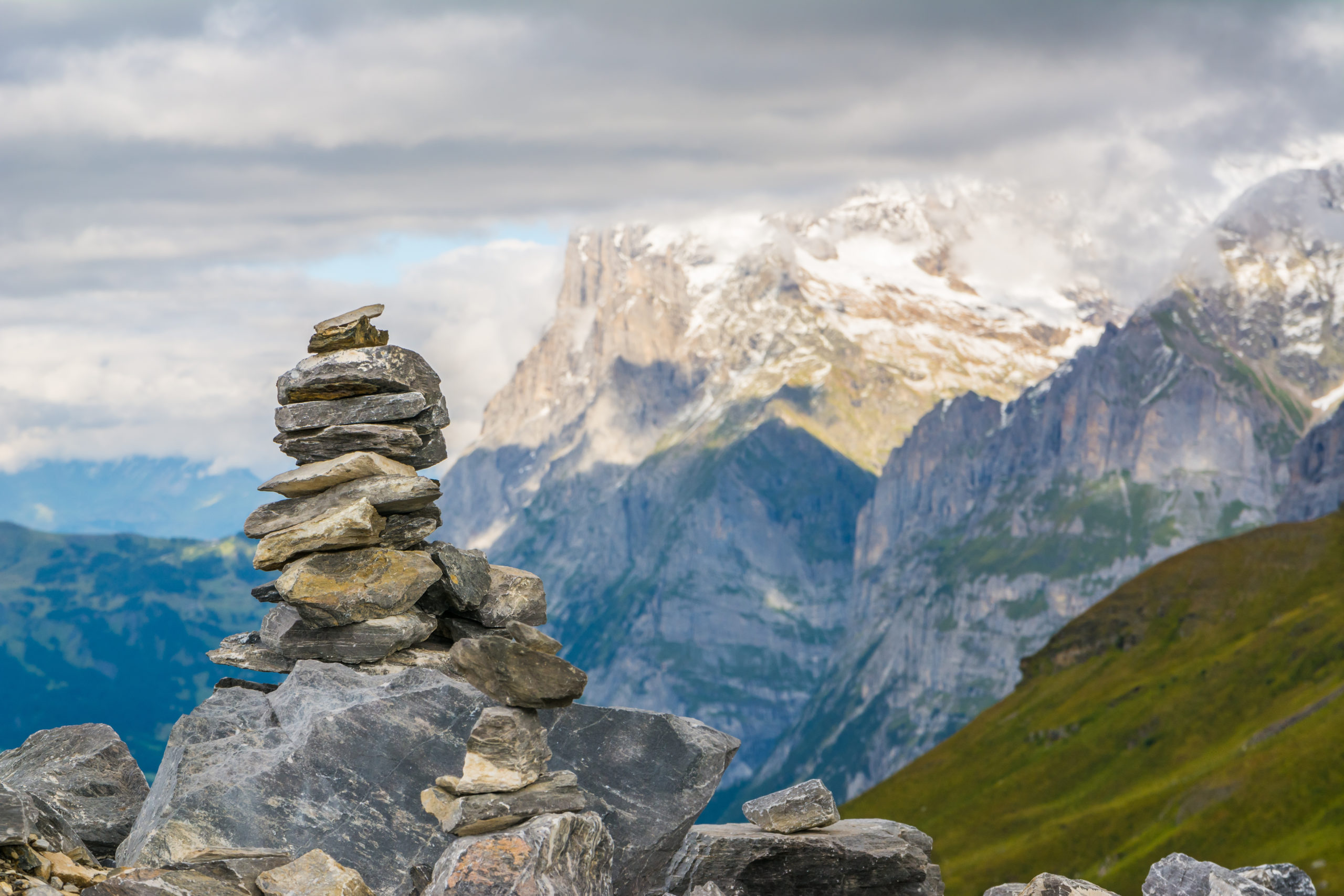When embarking on a hike through the serene beauty of nature, it’s not uncommon to encounter stacks of rocks known as cairns along the trail. These seemingly innocent formations have become a subject of debate among hikers and conservationists. While some argue that cairns serve as valuable wayfinding tools and symbols of community, others emphasize the environmental harm and navigation confusion they can cause. In this article, we’ll delve into the reasons why you shouldn’t stack rocks on hikes and provide guidance on how to responsibly interact with them when encountered on your outdoor adventures.

Are Rock Cairns on Hiking Trails Beneficial or Harmful?
Picture the scene: you’ve huffed and puffed your way to the top of the local trig point as part of your New Year’s resolution. While the view from the top is worth the effort, the summit of the footpath is also covered in loads of stacked rocks, or cairns. The word “cairn” comes from the Scottish Gaelic word meaning “heap of stones”. Despite featuring on all those hot-girl-walk Instagram accounts, what are they, and why are they there?
Rock cairns on hiking trails have sparked a contentious debate within the outdoor enthusiast community regarding their benefits and potential drawbacks. These carefully stacked piles of stones have been a fixture on trails for centuries, serving various purposes depending on who you ask. Some argue that rock cairns play a valuable role in assisting hikers with navigation, fostering a sense of community, and even acting as landmarks along the trail. They can be a reassuring sign that you’re on the right path, particularly in areas where the terrain is challenging or the trail is not well-marked.
To strike a balance between the potential benefits and drawbacks of rock cairns, it’s crucial for hikers to be aware of responsible practices while on the trail. Utilizing official trail markers, maps, GPS devices, or compasses can help ensure accurate navigation without relying solely on cairns. Additionally, raising awareness about the ecological consequences of unauthorized rock cairns and encouraging fellow hikers to prioritize environmental conservation can contribute to a more sustainable hiking experience. Ultimately, the question of whether rock cairns are beneficial or harmful depends on how they are used, their context, and the collective responsibility of hikers to protect the natural beauty of the trails they love.
What are rock cairns?
Usually, these kinds of rock cairns are built to show hikers the way on particularly confusing routes; you can find them dotted all throughout famous trails like the Camino de Santiago. However, recently cairns have been popping up all over hiking trails, often in groups, usually by particular features or rest stops.

Transferring a rock from one location to another might unintentionally disrupt the abode of a small creature residing beneath it. This action may also contribute to soil erosion or result in the obliteration of the fragile microenvironments that both plants and animals rely on for their survival. Furthermore, shifting a stone with the intent of adding it to the peak of a cairn could potentially lead to the entire structure’s collapse, which goes against the original purpose of building it.
Where do rock cairns come from?
Cairns are thought to have been started by Waldron Bates, who was the lead author of an island path map published in 1896. He was devoted to maintaining hiking trails and wrote a handbook to establish standards of how things should be done. He also established how cairns should be built in a style now known as the Bates cairn, quite different from the simple stacks we see today.
One of Bates’ significant contributions was the establishment of guidelines for building cairns, a style now referred to as the Bates cairn. Interestingly, these early cairns were quite different from the simple stacked stone formations we commonly encounter today. Bates’ vision for cairns was rooted in functionality and navigation, emphasizing their role as trail markers.
Over time, the concept of rock cairns evolved beyond utility, taking on new meanings for different hikers and trail-goers. While they still serve as markers and directional aids on challenging trails, they have also become symbolic of community, adventure, and exploration. Despite this evolution, the core message remains: tread lightly, respect the environment, and preserve the beauty of our natural landscapes.
What should you do if you see a rock cairn?
Wondering how to handle the sight of a rock cairn? According to guidance from the National Parks Service, the best course of action is to refrain from any interference, construction, or augmentation of existing cairns. Resisting the temptation to topple them is equally important. And if ethical reasons are not persuasive enough, it’s worth noting that such actions may be regarded as vandalism, potentially leading to legal consequences, as it is against the law.
It’s important to recognize that disturbing these cairns can have consequences beyond the trail’s aesthetics. In fact, the act of moving rocks from one cairn to another or toppling them over may be considered vandalism under the law. Vandalism in protected natural areas not only disrupts the environment but also carries legal repercussions.
Other Research on Rock Cairns and Hiking
While there is ongoing debate about the benefits and drawbacks of rock cairns on hiking trails, researchers have conducted studies to shed light on the issue. One study published in the Journal of Outdoor Recreation and Tourism found that rock cairns can have positive impacts on hiker experiences, such as providing a sense of place and acting as landmarks. However, it also highlighted the importance of responsible cairn building and maintenance to avoid negative consequences.
Another study published in Environmental Management explored the effects of rock stacking on vegetation and arthropod communities. The findings suggested that building rock cairns can disrupt native plant species and disturb the habitats of insects and other small organisms, thereby impacting biodiversity. The study emphasized the need for hikers to consider the ecological implications of their actions.
Tips for Hiking Responsibly
While the debate on rock cairns continues, it’s essential to prioritize responsible hiking practices. Here are some tips to ensure you leave no trace and minimize your impact on the environment:
1. Follow the principles of Leave No Trace: Pack out your trash, respect wildlife and their habitats, and stick to designated trails.
2. Use official trail markers: Rely on established signage, maps, and wayfinding tools such as GPS devices or compasses to navigate trails instead of relying solely on rock cairns.
3. Educate yourself: Learn about the specific regulations and guidelines of the hiking area you plan to visit. Familiarize yourself with the local flora, fauna, and wildlife conservation efforts.
4. Share the knowledge: Spread awareness about responsible hiking practices and the potential negative impacts of unauthorized rock cairns. Encourage fellow hikers to respect nature and minimize their impact on the trails.
5. Support conservation efforts: Consider donating to organizations involved in preserving and maintaining hiking trails. Participate in volunteer initiatives or join local conservation groups to actively contribute to the protection of natural environments.

Balancing Navigation and Environmental Conservation
Rock cairns on hiking trails can be a controversial topic, with arguments for both their benefits and potential harm. While they can provide navigation assistance and a sense of community, building unauthorized cairns can disrupt ecosystems and confuse hikers. It is crucial to strike a balance between effective trail navigation and environmental conservation.
Ultimately, the responsibility falls on hikers to make informed choices and prioritize the preservation of natural spaces. By adopting responsible hiking practices, respecting trail guidelines, and promoting environmental stewardship, we can ensure that future generations can enjoy the beauty of hiking trails while preserving the delicate ecosystems they traverse.
Remember, when you venture out into nature, leave only footprints, take only memories, and respect the wilderness that allows us to find solace and adventure.

This Site Was Inspired By An Interest in Protecting the Environment:
We had the privilege and joy of learning from Dr. Charlie Stine who instilled a love for the natural world through incredible field trips with the Johns Hopkins Odyssey Certificate program in Environmental Studies. At the time, the program was endorsed by the Maryland Department of Natural Resources. Sadly, after Dr. Stine retired, the program was phased out. We hope that we honor his legacy by shining a bright light on environmental issues and sharing good news about the success of various conservation programs when possible.
